Ascending midbrain dopaminergic axons require descending GAD65 axon fascicles for normal pathfinding
- PMID: 24926237
- PMCID: PMC4046268
- DOI: 10.3389/fnana.2014.00043
Ascending midbrain dopaminergic axons require descending GAD65 axon fascicles for normal pathfinding
Abstract
The Nigrostriatal pathway (NSP) is formed by dopaminergic axons that project from the ventral midbrain to the dorsolateral striatum as part of the medial forebrain bundle. Previous studies have implicated chemotropic proteins in the formation of the NSP during development but little is known of the role of substrate-anchored signals in this process. We observed in mouse and rat embryos that midbrain dopaminergic axons ascend in close apposition to descending GAD65-positive axon bundles throughout their trajectory to the striatum. To test whether such interaction is important for dopaminergic axon pathfinding, we analyzed transgenic mouse embryos in which the GAD65 axon bundle was reduced by the conditional expression of the diphtheria toxin. In these embryos we observed dopaminergic misprojection into the hypothalamic region and abnormal projection in the striatum. In addition, analysis of Robo1/2 and Slit1/2 knockout embryos revealed that the previously described dopaminergic misprojection in these embryos is accompanied by severe alterations in the GAD65 axon scaffold. Additional studies with cultured dopaminergic neurons and whole embryos suggest that NCAM and Robo proteins are involved in the interaction of GAD65 and dopaminergic axons. These results indicate that the fasciculation between descending GAD65 axon bundles and ascending dopaminergic axons is required for the stereotypical NSP formation during brain development and that known guidance cues may determine this projection indirectly by instructing the pathfinding of the axons that are part of the GAD65 axon scaffold.
Keywords: NCAM; Robo; axon interaction; dopaminergic; fasciculation; nigrostriatal pathway.
Figures
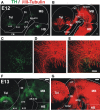

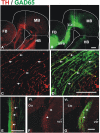


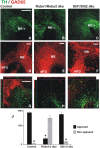
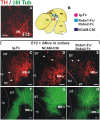
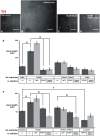
Similar articles
-
TNF superfamily member APRIL enhances midbrain dopaminergic axon growth and contributes to the nigrostriatal projection in vivo.Exp Neurol. 2017 Dec;298(Pt A):97-103. doi: 10.1016/j.expneurol.2017.09.007. Epub 2017 Sep 11. Exp Neurol. 2017. PMID: 28911883 Free PMC article.
-
Semaphorins 3A, 3C, and 3F in mesencephalic dopaminergic axon pathfinding.J Comp Neurol. 2008 Jan 20;506(3):387-97. doi: 10.1002/cne.21503. J Comp Neurol. 2008. PMID: 18041777
-
Embryonic GABAergic spinal commissural neurons project rostrally to mesencephalic targets.J Comp Neurol. 2004 Jul 26;475(3):327-39. doi: 10.1002/cne.20166. J Comp Neurol. 2004. PMID: 15221949
-
Robo1 regulates the development of major axon tracts and interneuron migration in the forebrain.Development. 2006 Jun;133(11):2243-52. doi: 10.1242/dev.02379. Development. 2006. PMID: 16690755
-
Regulation of commissural axon pathfinding by slit and its Robo receptors.Annu Rev Cell Dev Biol. 2006;22:651-75. doi: 10.1146/annurev.cellbio.21.090704.151234. Annu Rev Cell Dev Biol. 2006. PMID: 17029581 Review.
Cited by
-
Gestational Exposure to Sodium Valproate Disrupts Fasciculation of the Mesotelencephalic Dopaminergic Tract, With a Selective Reduction of Dopaminergic Output From the Ventral Tegmental Area.Front Neuroanat. 2020 Jun 5;14:29. doi: 10.3389/fnana.2020.00029. eCollection 2020. Front Neuroanat. 2020. PMID: 32581730 Free PMC article.
-
Neuronal Subset-Specific Migration and Axonal Wiring Mechanisms in the Developing Midbrain Dopamine System.Front Neuroanat. 2017 Jul 10;11:55. doi: 10.3389/fnana.2017.00055. eCollection 2017. Front Neuroanat. 2017. PMID: 28740464 Free PMC article. Review.
-
Neurophilic Descending Migration of Dorsal Midbrain Neurons Into the Hindbrain.Front Neuroanat. 2018 Nov 13;12:96. doi: 10.3389/fnana.2018.00096. eCollection 2018. Front Neuroanat. 2018. PMID: 30483071 Free PMC article.
-
ROBO2 signaling in lung development regulates SOX2/SOX9 balance, branching morphogenesis and is dysregulated in nitrofen-induced congenital diaphragmatic hernia.Respir Res. 2020 Nov 18;21(1):302. doi: 10.1186/s12931-020-01568-w. Respir Res. 2020. PMID: 33208157 Free PMC article.
-
The discovery of the growth cone and its influence on the study of axon guidance.Front Neuroanat. 2015 May 15;9:51. doi: 10.3389/fnana.2015.00051. eCollection 2015. Front Neuroanat. 2015. PMID: 26029056 Free PMC article. Review.
References
-
- Albanese A., Altavista M. C., Rossi P. (1986). Organization of central nervous system dopaminergic pathways. J. Neural Transm. Suppl. 22, 3–17 - PubMed
-
- Auclair F., Marchand R., Glover J. C. (1999). Regional patterning of reticulospinal and vestibulospinal neurons in the hindbrain of mouse and rat embryos. J. Comp. Neurol. 411, 288–300 - PubMed
Grants and funding
LinkOut - more resources
Full Text Sources
Other Literature Sources
Molecular Biology Databases
Research Materials
Miscellaneous

